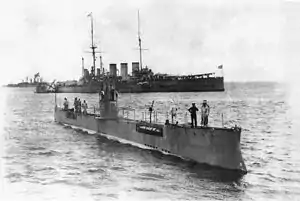 Russian submarine Akula with the armored cruiser Rurik in the background | |
| History | |
|---|---|
| Name | Akula |
| Ordered | 1906 |
| Builder | Baltic Yard, Saint Petersburg |
| Launched | 4 September 1907 |
| Fate | Sunk by mine, 28 November 1915 |
| General characteristics | |
| Type | Submarine |
| Displacement |
|
| Length | 56 m (183 ft 9 in) |
| Beam | 3.7 m (12 ft 2 in) |
| Draft | 3.4 m (11 ft 2 in) |
| Propulsion |
|
| Speed |
|
| Range |
|
| Complement | 34 |
| Armament | 4 × 18-inch (457 mm) torpedo tubes (bow) and 4 Drzewiecki drop collars |
Akula (Russian: Акула; meaning shark) was a submarine built for the Imperial Russian Navy. Akula saw service during World War I and sank in November 1915 after hitting a naval mine.
Design and construction
The boat was designed by Ivan Bubnov and was an amalgam of the previous Minoga and the Kasatka-class submarine designs. The design was presented to the Marine technical committee in late 1905 and was ordered in 1906.
Akula was built at the Baltic shipyard in Saint Petersburg.[1] The vessel was launched on 4 September 1907.
Service history

Initially the boat was to use petrol engines but these were replaced by safer diesels. The boat's design was a single hull/ saddle tank type with a diving depth of 25 fathoms (45 meters (148 ft)).
Significant initial problems were experienced and the electric motor and propellers which needed to be replaced. Akula was the first Russian submarine able to cruise long distances. In 1912 Akula made the world's first multi-torpedo volley with five torpedoes.
She subsequently served in the Baltic Fleet during World War I making 16 patrols and unsuccessfully attacked the German coastal defense ship SMS Beowulf.
On 10 October 1914, Akula ran aground in the Soeloesund. She was refloated with assistance from the gunboat Brave.[2] She struck a mine and sank near Hiiumaa[3] in November 1915 on her 17th patrol. Akula lies about 30 meters (98 ft) below water. All 35 members of the crew died.[4]
Notes
- ↑ Einmann, Andres (3 December 2014). "Eesti võttis uppunud Tsaari-Venemaa allveelaeva kaitse alla" (in Estonian). Postimees. Retrieved 8 July 2015.
- ↑ Chernyshev, Alexander Alekseevich (2012). Погибли без боя. Катастрофы русских кораблей XVIII–XX вв [They died without a fight. Catastrophes of Russian ships of the XVIII-XX centuries] (in Russian). Veche. Archived from the original on 19 August 2022. Retrieved 15 November 2021.
- ↑ "Akula (Акула) (+1915)". wrecksite.eu.
- ↑ "Hiiumaa lähistelt leiti sajandivanune unikaalne Vene allveelaev" (in Estonian). Delfi.ee. 25 June 2014. Archived from the original on 28 June 2014. Retrieved 8 July 2015.
References
- Gardiner, Robert; Gray, Randal, eds. (1985). Conway's All the World's Fighting Ships 1906–1921. Annapolis, Maryland: Naval Institute Press. ISBN 0-85177-245-5.